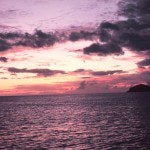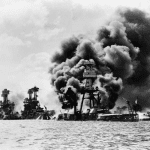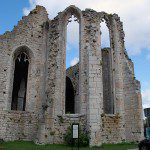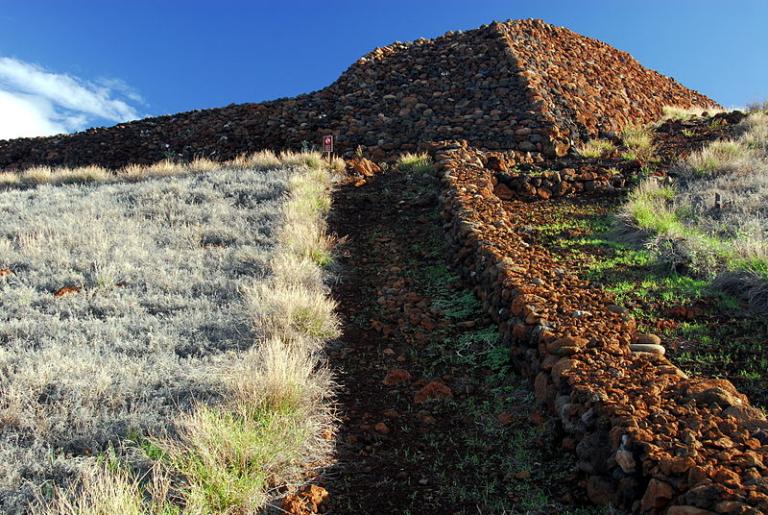
(Wikimedia Commons public domain image)
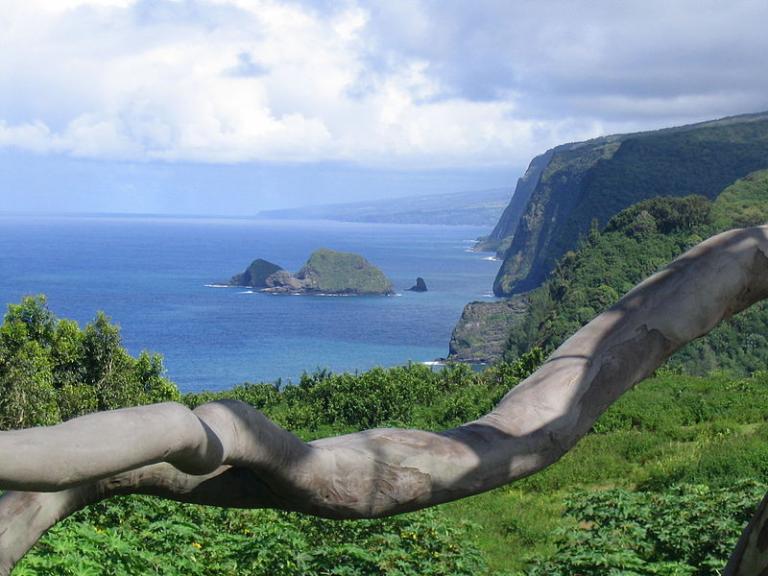
(Wikimedia Commons public domain image)
We briefly visited the Pu’ukoholā Heiau this afternoon. (The word heiau is typically translated as “temple.”) My wife and I paid it a longer visit several years ago, when we fairly systematically visited several heiaus. An excellent film at the visitor center, new since we were last here, explains very clearly the events surrounding the construction of the sanctuary during parts of 1790 and 1791 by King Kamehameha I (“the Great”) — who sometimes labored with his own hands to complete it. The stone is said to have come via a human chain, over twenty miles long, from the Pololū Valley, a magnificent place that we also visited today.
The story is a bloody one. By this point, Kamehameha had already conquered Maui, Molokai, and Lanai, but his arch-rival for sovereignty over his own native island of Hawaii, was still a threat. This was his cousin Keōua Kuahuʻula, who had even invaded Kamehameha’s territory while Kamehameha was off busy conquering Molokai. Frustrated, Kamehameha learned from a prophet that, if he built a heiau to the Hawaiian war god Kūkā’ilimoku (“Kū, snatcher of islands”) on Pu’ukoholā, “the hill of the whale,” he would prevail over all his enemies and become king of all the islands.
Pu’ukoholā Heiau was built as a luakini — which is to say that it was built to be a sacrificial temple, where both animal and human offerings were made. Workers were sacrificed along the way during construction, but the most famous of those human sacrifices was that of Kamehameha’s cousin, Keōua Kuahuʻula. Keōua’s sacrifice ended the threat on the home front and inaugurated the new heiau.
“For Hawaiians today,” say both the movie and the relevant National Park literature, “Pu’ukohola Heiau National Historic Site continues to be a symbol of unification and lasting peace.”
I find that assertion much more than slightly problematic: Neither Kamehameha’s unification of the Hawaiian Islands nor his construction of the Pu’ukoholā Heiau was even remotely peaceful. Both were accomplished by brute force.
Just offshore is the Hale o Kapuni Heiau, an ocean temple dedicated to the shark gods, where human sacrifices also took place. (You can roughly imagine how they were carried out.) Its rock platform was once visible during low tides, but it has apparently now been covered with silt and it hasn’t been seen since sometime in the 1950s
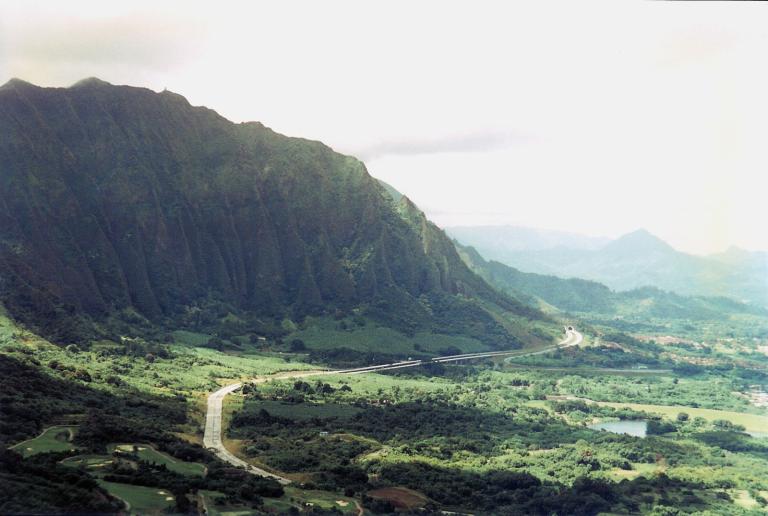
(Wikimedia Commons public domain image)
The ancient Hawaiian religion had developed into an ideology that seems to have focused to a large degree on enforcing rigid class stratification, and it was extraordinarily fierce. The chiefs, the ali’i, were in charge, and they were supported by a long list of taboos, for which the Hawaiian word is kapu. (Tabu, from Tongan, and kapu, from Hawaiian, are close cognates illustrating a pretty standard Polynesian consonantal shift; it was apparently Captain James Cook, who met his remarkably grisly end in 1779 just a few miles south of where I’m typing, who introduced the Tongan word taboo into English.) Under the ancient religion, for example, it was kapu for a commoner’s shadow to fall across the ali‘i’s shadow. It was kapu to interrupt the ali’i when he was speaking. It was kapu for one of a lower class to walk on certain trails reserved for the ali’i. It was kapu to fail to observe the sacred days of the ritual calendar. It was kapu for women to eat pork or bananas, and for men and women to eat together. It was kapu to prepare food for men in a container that had been used or that would be used to prepare food for women. Certain areas were off limits, kapu, for fishing. And the penalty for violating kapu was usually death by fire, or by clubbing, or by being run through with a spear, or by strangulation, unless the offender could make his or her way to a recognized place of refuge without being captured or killed first. Moreover, if the offense were deemed a sufficiently serious one, the entire family of the guilty party might be put to death for it.
According to rumor, certain critics of the Restoration have allegedly mused that the Hawaiian kapu system may even, on occasion, have been nearly as oppressive and misogynistic as the Church of Jesus Christ of Latter-day Saints itself. But there is little if any hard evidence to support that rumor.
Apparently, more than a few Hawaiians were themselves unhappy with the system, and not merely among the lower ranks (who might reasonably be expected to have chafed under it). In fact, Kamehameha the Great himself banned human sacrifices, apparently after his final unification of all of the Hawaiian Islands in 1810.
Kamehameha I died on either 8 May or 14 May 1819, and was succeeded by his son. Later that very year, in 1819, King Kamehameha II — acting in concert with his mother, Queen Keōpūolani, his father’s other queen Kaʻahumanu, and the kahuna-nui or chief priest Hewahewa — suddenly abolished the kapu system. He did so by the simple but powerfully symbolic act of sharing a meal of kapu foods with the women of his royal court. Interestingly, although Captain Cook had “discovered” the Hawaiian Islands already in 1778, thus making first European contact with the natives, the complex system of taboos was abolished, at the sole initiative of Hawaiians, a year before the arrival of the earliest Christian missionaries in Hawaii.
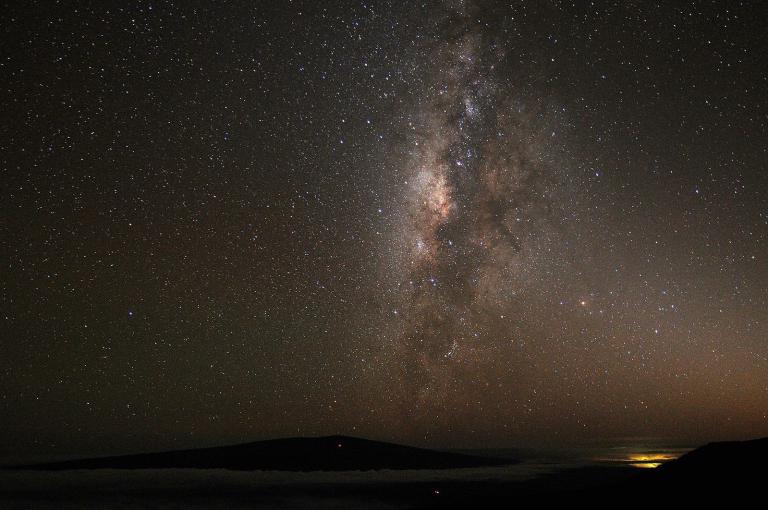
(Wikimedia Commons public domain image)
Our edition may well be a bit out of date, but our preferred local guidebook here is Andrew Doughty, Hawaii: The Big Island Revealed: The Ultimate Guidebook (Lihu’e, HI: Wizard Publications, 2018). This passage, from page 15, caught my attention:
By the 1700s, the Hawaiians had lost all contact with Tahiti, and the Tahitians had lost all memory of Hawai’i. Hawaiian canoes had evolved into fishing and interisland canoes, and were no longer capable of long ocean voyages. The Hawaiians had forgotten how to explore the world.
That description reminds me, of course, of the Disney movie Moana. But not only of Moana.
Posted from Waikōloa, Hawai’i Island, Hawai’i



